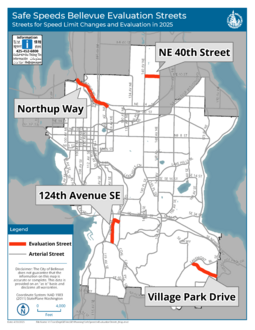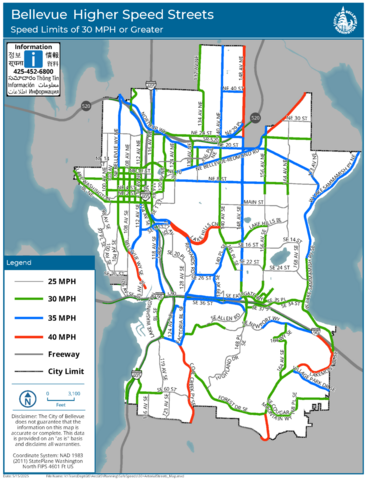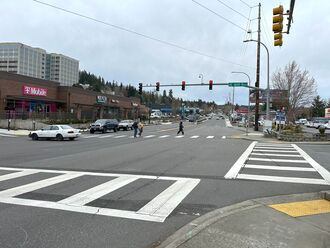
Safe Speeds Bellevue is a new program to improve safety and support Vision Zero by evaluating speed limits and reducing speeds on city streets. The initial phase of Safe Speeds Bellevue will review speed limits on all city streets that currently have a speed limit of 30 mph or more.
Reducing speed limits is a practical and effective way to make streets safer. Lower speeds decrease the likelihood of a crash occurring and the severity of a crash when it does occur. Setting safe speeds reduces the frequency of all crashes, not just speeding-related crashes. Reducing speed limits is proven in Bellevue, Seattle and other cities to effectively reduce high-end speeding.
Safe speeds are also an essential component of the Safe System approach. This approach was adopted by the council in 2020 and provides a framework for Bellevue to reach the adopted Vision Zero goal of eliminating traffic deaths and serious injuries on city streets by 2030. You can learn more about the Safe System approach on our Vision Zero webpage.
Current status
Safe Speeds Bellevue was introduced at the City Council meeting on May 20. At this meeting, the council directed staff to begin outreach on Safe Speeds Bellevue. They also directed staff to prepare an ordinance to reduce the speeds on four arterial streets and evaluate the impacts. The speed limit on portions of 124th Avenue Southeast/Southeast 38th Street and Northup Way from Bellevue Way to 120th Avenue Northeast will be reduced from 35 to 25 mph. The speed limit on Village Park Drive and a portion of Northeast 40th Street will be reduced from 35 to 30 mph. Staff will study how people using these streets respond to the new speed limits and then use this data to inform future phases of the project. Flyers will be sent to addresses near each of these streets prior to the change being made.
Currently, staff are working to determine target speeds for all 30+ mph streets and will recommend changing the speed limit where target speeds differ from the current speed limits. Any speed limit changes would need to be approved by the council. Target speeds represent the highest speed people should drive vehicles on a street in a specific context. More information about target speeds is available in the frequently asked questions below under “How are speed limits being determined?”
What streets are we looking at and why?
The initial phase of Safe Speeds Bellevue focuses on city streets that currently have a speed limit of 30 mph or higher. Generally, these are the streets that take you to daily destinations, like jobs, grocery stores, healthcare, shopping areas, recreation areas, as well as connecting to the freeway system. These streets are a focus because although they are a minority of streets, they account for the majority of traffic crashes. In Bellevue, almost 90% of fatal and serious injury crashes happen on streets with speed limits of 30 mph or higher. However, these streets are only 25% of total road mileage.
Safe Speeds Bellevue will not be reviewing state highways or private roads. In 2024, Bellevue City Council passed an ordinance changing the speed on most local streets from 25 to 20 mph, with implementation planned for 2026.
How to get involved
The project team will be sharing information and answering questions at a variety of online and in-person events. They will be listed here as they are scheduled.
Are you part of a community group that wants to host our team to hear more about the project and ask questions? Please email safespeeds@bellevuewa.gov to schedule a time.
Online
- Take our online survey, open now until September 30. Your feedback will help the city make decisions about speed limits and where to prioritize speed limit reductions to improve safety.
- Explore the frequently asked questions below.
- Submit a question or comment using the virtual comment box below.
- Watch our video overview:
Timeline
Safe Speeds Bellevue is the next step in the city’s efforts to improve safety for everyone who uses our transportation network.
- 2025-2026: Safe Speeds Bellevue will determine target speeds for all 30+ mph roads and will use Safe Streets and Roads for All (SS4A) grant funding to conduct citywide speed studies.
- 2024: The council approved a new Vision Zero Safe Speeds Program capital budget that allocated $4.7 million for safe speeds work from 2025-2030.
- 2024: The council passed an ordinance lowering the speed limit on most local streets to 20 mph. This project is currently in design, and signs are anticipated to be updated in 2026.
- 2023: The USDOT awards the City of Bellevue $2.8 million through an SS4A grant, which includes funding to conduct citywide speed studies.
- 2021-2023: The Transportation Department created the Speed Management Plan.
- 2020: The council passed a resolution approving the Safe System approach and strategies to move Bellevue towards Vision Zero. The Vision Zero Strategic Plan was approved by the City Manager, which includes information and strategies for Safe Speeds.
- 2015: The council passed a resolution providing a framework to pursue Vision Zero.
In future phases of Safe Speeds Bellevue, the city anticipates implementing physical changes on streets to encourage safe speeds by design. Staff will also monitor speed and crash data citywide to track progress towards the 2030 Vision Zero goal and identify targeted street improvements.
Frequently Asked Questions
What streets are being evaluated for lower speeds?
All streets in Bellevue that have a speed limit of 30 miles per hour and more will be evaluated through Safe Speeds Bellevue. The map above shows all the locations.
How are speed limits being determined?
The proposed speed limits would be the target speed, which represent the highest speed people should drive vehicles on a street in a specific context. Identifying target speeds considers two factors to determine speed limits: conflict density and activity level.
Conflict Density
Conflict Density is how frequently potential conflicts arise between different road users. It is split into two categories: Modal Mixing and Crossing Point Density.
Modal Mixing looks at how people using different travel modes, like people walking, rolling, bicycling and driving, interact with each other. An example of low modal mixing is a street where people are walking on a sidewalk separated by a landscape strip, meaning there is less opportunity for conflict between people walking and driving. An example of high modal mixing would be where people are walking on a paved shoulder next to people driving. Generally, higher modal mixing supports lower speed limits.
Crossing Point Density measures how many opportunities there are for people to cross or enter the street where people are driving. If there are lots of driveways where people driving need to enter the street, and intersections and other marked crosswalks where people walking and rolling may be crossing the street, the Crossing Point Density will be higher. Generally, more crossing points support lower speed limits.
Activity Level
Activity Level describes how active a street is now or is expected to be in the near future. It considers how many people are walking and rolling along the street, what sort of public spaces are next to the road, current or future bike routes, transit usage, and curbside demand (ex. parking, delivery drivers). Generally, more activity supports lower speed limits.
Have other streets in Bellevue already had their speed limits lowered?
Three neighborhoods in Bellevue (Surrey Downs, East Bellevue Greenway, and parts of Eastgate around Tyee Middle School) had speed limits on local streets reduced from 25 to 20 mph. Each of these changes reduced high-end speeding. In 2024, The council passed an ordinance lowering the speed limit on most local streets from 25 to 20 mph, and signs are anticipated to be updated in 2026. In February 2025, the council passed an ordinance lowering the speed limit on a portion of Coal Creek Parkway from 40 to 35 mph. It is anticipated the signs for the speed limit will be changed in summer 2025.
Do lower speed limits improve safety?
Yes. Lower speed limits have been shown to reduce the speed people drive, especially high-end speeding. In Bellevue, reducing local street speed limits in the Eastgate neighborhood from 25 mph to 20 mph led to a 19% decrease in people driving 30 mph or more. Driving at a lower speed reduces braking distance and increases the cone of vision for people driving, allowing drivers to see more of the street and travel a shorter distance when reacting to a change. Crashes at lower speed limits are less forceful and are less likely to result in a fatal or serious injury. Lower speed limits have resulted in fewer overall crashes and fatal and serious injury crashes in cities across the US. In Seattle, reduced speed limits and increased speed limit signage resulted in a 22% decrease in all crashes and an 18% decrease in injury crashes, as well as a 54% decrease in high-end speeding.
What if people don’t slow down after speed limits are lowered?
In Bellevue, Seattle and many other cities across the US, a reduction in the speed limit and increased speed limit signage alone reduced the speeds that people were driving. However, if people do not slow down after the speed limits are lowered, there are a variety of countermeasures the city can use to encourage driving at lower speeds. This includes changes to the street like narrowing lanes or adding speed cushions, as well as adding technology such as radar feedback signs or speed safety cameras. A toolbox of countermeasures is provided in the Speed Management Plan. The council approved a new Vision Zero Safe Speeds Program capital budget that allocated $4.7 million for safe speeds work from 2025-2030, which can be used to fund these countermeasures.
How are speed limits enforced?
Speed limits in Bellevue are enforced by the Bellevue Police Department. Speed limits are also enforced in some locations in Bellevue with automated photo enforcement. The Transportation Department is currently assessing existing policies on automated photo enforcement. You can request enforcement at a specific location through the Traffic Service Request form.
When would new speed limits go into effect?
Four streets will have their limits lowered this summer. The speed limit on portions of 124th Avenue Southeast/Southeast 38th Street and Northup Way between Bellevue Way and 120th Avenue Northeast will be reduced from 35 to 25 mph. The speed limit on Village Park Drive and a portion of Northeast 40th Street will be reduced from 35 to 30 mph. Staff will study how people using these streets respond to the new speed limits and then use this data to inform future phases of the project. Currently, it is anticipated that all other new speed limits will go into effect in 2027 after they are approved by the council and updated with new signs.
Documents
- Flyer (July 2025)
- Evaluation corridors speed limit reduction mailers (June 2025)
- 124th Avenue Southeast/Southeast 38th Street (English, 简体中文, 繁體中文, 한국어
- Northup Way from Bellevue Way to 120th Avenue Northeast (English, 简体中文, 繁體中文, 한국어, Español, Русский)
- Village Park Drive (English, 简体中文, 한국어, Español)
- Northeast 40th Street from 140th to 148th Avenues Northeast (English, 简体中文, 繁體中文, Español, Русский, తెలుగు)
- Map of existing speed limits
- City Council (May 20, 2025): Agenda Memo, Map of Four Evaluation Streets, Map of Bellevue Streets with a Current Speed Limit of 30 MPH or Higher, CIP Project Description (PW-R-219), Proposed amendments to Chapter 11.32 of the Bellevue City Code


